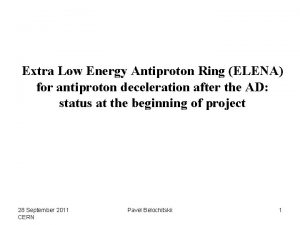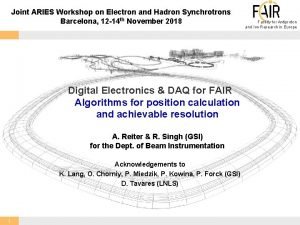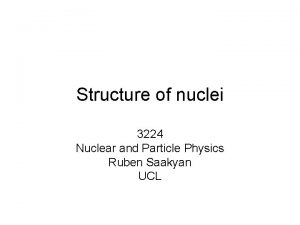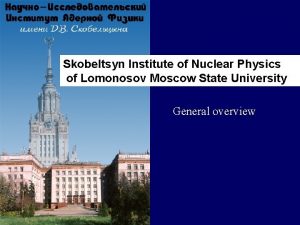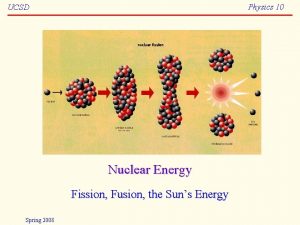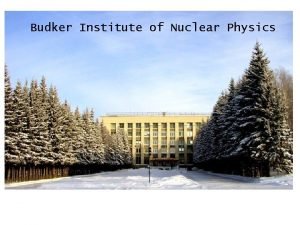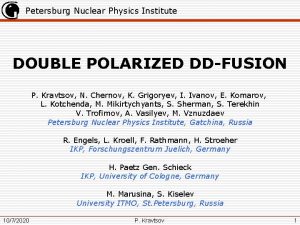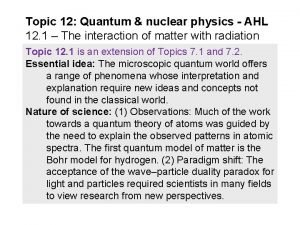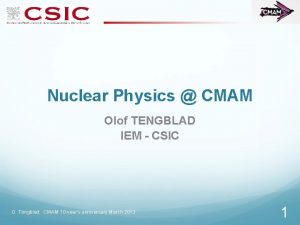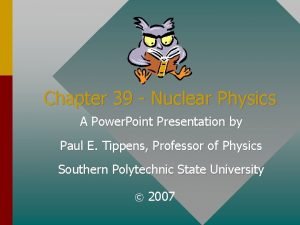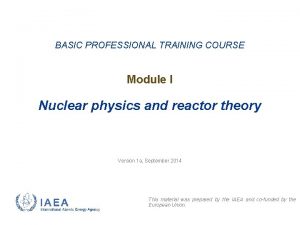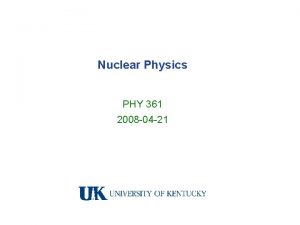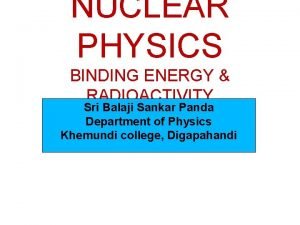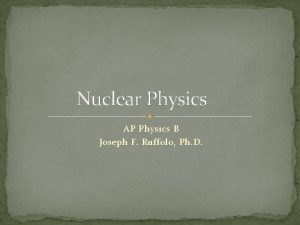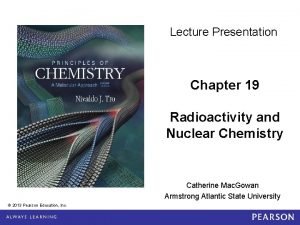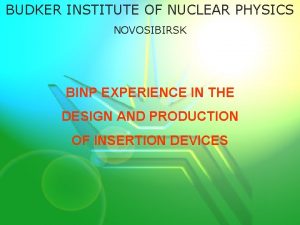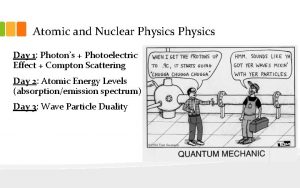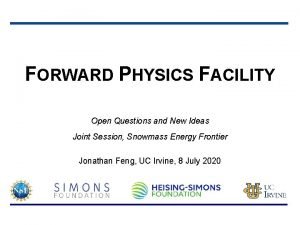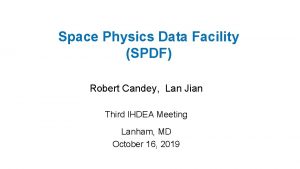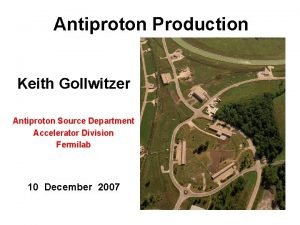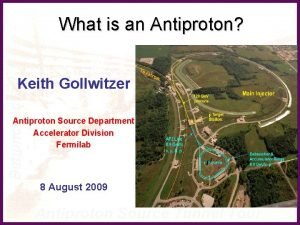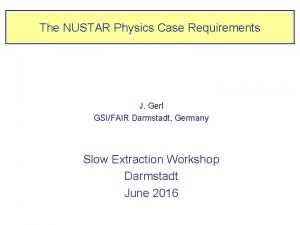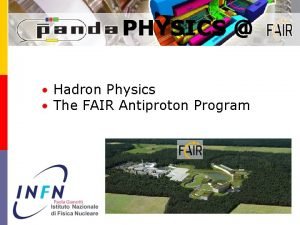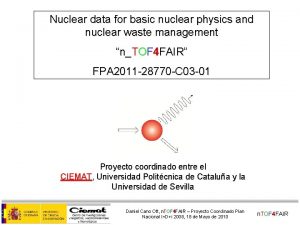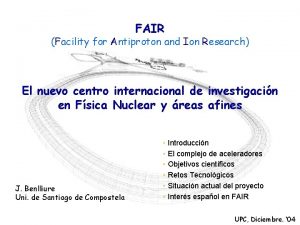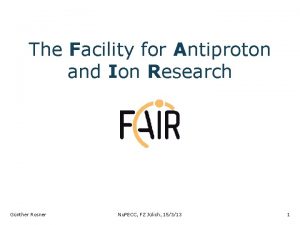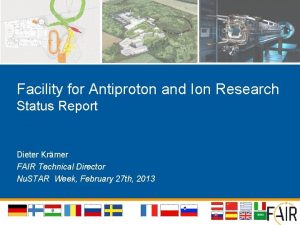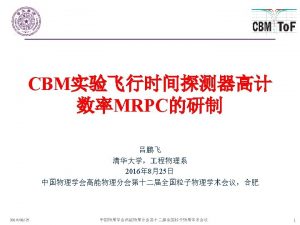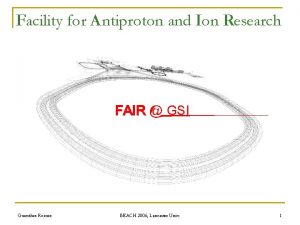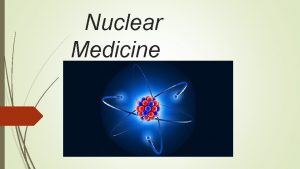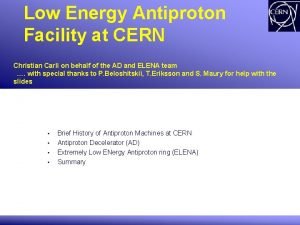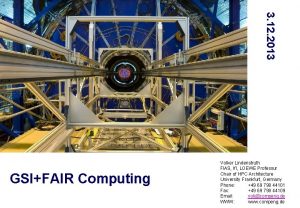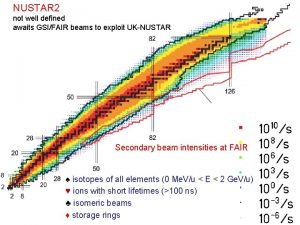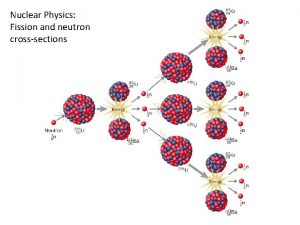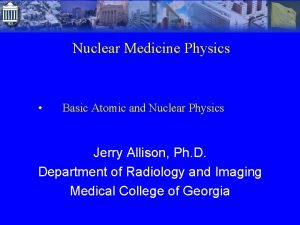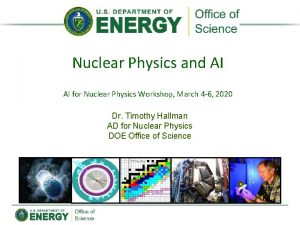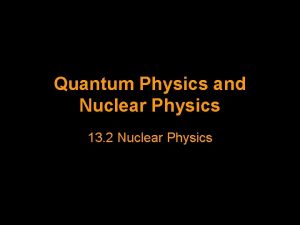Nuclear Physics at GSIFAIR Facility for Antiproton and


























































- Slides: 58

Nuclear Physics at GSI/FAIR (Facility for Antiproton and Ion Research)

The GSI/FAIR facility GSI FAIR

Strengths of GSI/FAIR • Only facility world-wide able to provide a 238 U 28+ beam at 1. 5 A Ge. V with ~1011 pps • World-record intensities for radioactive beams of fully stripped ions up to the heaviest masses near U • Large variety of energies (stopped, Me. V/u, >1 Ge. V/u) • High-quality radioactive beams (beam cooling at rings), unrivalled experience • State of the art detection systems are or will be available

Experiments at GSI/FAIR • FAIR-phase 0 is running, current experiments benefit from the upgrade of UNILAC and SIS-18, and from CRYRING • First experiments using the Super-FRS expected towards the end of 2025 • France is one of the 10 share-holders of FAIR and enables its scientific community the access to FAIR

Nuclear-physics projects at GSI/FAIR coordinated by IN 2 P 3 scientists (2020 -2024) For AGATA@FAIR, see talk by A. Lopez-Martens! Ideas for experiments with GRIT@FAIR, see talk by D. Baumel

Overview of French projects (Pairing correlations) 2 -proton radioactivity Neutron-neutron correlations

Overview of French projects (Evolution of shells, onset of deformation and collectivity) Nuclear Shape PRL 102, 092501 (09) Energy Magnetic moments of isomeric states Nuclear Spin Nature 399, 35 (99)

Overview of French projects (Nuclear fission, extreme deformation) Fission barriers Fission probabilities Fissionfragment yields

Overview of French projects (Limits of stability, super-heavy nuclei) Laser spectroscopy

Evolution of pairing correlations towards the neutron dripline from di-neutron and tetra-neutron correlations O. Sorlin, GANIL

Motivation: • Evolution of pairing scheme towards drip-line, from BCS to BEC ? (Hagino et al. PRL 99 (2007)) • Existence of an ensemble of 4 interacting neutrons? (Marques et al. , PRC 65 (2002), Kisamori et al. PRL 116 (2016)) 19 N High-energy proton knock out: Particularly well suited reaction mecanism to investigate 2 n or 4 n correlations: Suddenly promotes neutrons into the continuum without affecting the n-n correlations! Need of high energy projectile beams ~400 A Me. V! 19 N (-1 p) 18 C* -> 16 C+2 n R 3 B set-up (after FRS) n 16 C 19 N Cnn n C isotopes Largest cross section for the 14 C + 4 n channel -> 4 n correlations can be investigated in the future 18 C : Most correlated system ever observed! qnn A. Revel et al. Phys. Rev. Lett. 120, 152504 (2018)

Future studies of 2 n and 4 n correlations in atomic nuclei at FAIR/GSI Program: Experiment accepted, planned in 2020 Use of quasi-free proton knockout mechanism to promote 1 n, 2 n or 4 n in the continuum -1 n 17 B 14 Be 11 Li unbound Study of 2 n or 4 n correlations as a function of nuclear structure and the proximity of the drip -1 p line -> Evolution of nuclear superfluidity Spectroscopy of drip-line nuclei with excellent energy resolution -> shell evolution Means: Study of all steps of the reaction with full kinematics for ions and neutrons Very good (neutron) energy resolution (NEULAND), Highest efficiency worldwide Good g energy resolution and efficiency (CALIFA)

Two-proton radioactivity J. Govinazzo, CENBG

2 -proton radioactivity a unique & very exotic decay mode for unbound even-Z nuclei unbound… + Coulomb barrier + pairing correlations (proton-proton) physics motivation (beyond drip-line) pairing drip-line and masses tunnel effect nuclear structure • predicted in the 60’s indirect evidence in the 2000’s observed cases: 45 Fe (GANIL, GSI), 48 Ni (GANIL, NSCL), 54 Zn (GANIL), 67 Kr (RIKEN) • correlations (tracking exp. , TPC): 45 Fe [+ poor data on 54 Zn] difficult theoretical interpretation • combine decay dynamics & nuclear structure • new calculations (deformation) Gamow coupled channels CS-IN 2 P 3 – june 2019 need for various cases orbital configurations / deformation GSI / FAIR – 2 -proton radioactivity

2 -proton radioactivity @ GSI/FAIR current facilities (proj. fragmentation) – limited possibilities GANIL (95 Me. V/A) NSCL (160 Me. V/A) RIKEN (350 Me. V/A) ? n s & gio l l e e sh on r id i m mat r fo e d FAIR (FRS / Super-FRS) rate estimates (courtesy of B. Blank) 70 48 Ni / day with 58 Ni beam 50 more / GANIL 200 67 Kr / day with 78 Kr beam 20 more / RIKEN 100 71 Sr, 60 75 Zr / day with 92 Mo beam 10 79 Mo /day with 92 Mo beam 10 98 Sn /day with 124 Xe beam 67 Kr CS-IN 2 P 3 – june 2019 ) N KE I) (R S /G Z = 28 (Ni) L SC N A (G L/ NI AME 2016 isotopes ACTAR TPC 2 -step experiments search for candidates 45 Fe decay identification (DSSD) NUSTAR / DESPEC correlations (tracking exp. ) ACTAR TPC equipment already available Z = 36 (Kr) I 54 Zn 48 Ni Z = 50 (Sn) GSI / FAIR – 2 -proton radioactivity

Nuclear magnetic moments of isomeric states R. Lozeva, CSNSM

g. SPEC@FAIR Scientific motivation Unknown g factors for excited isomeric states : unknown configuration 18 collaboration Lo. Is @g. SPEC workshop 2018 • g factor : the dimensionless magnetic moment, M 1 operator • measure of the valence nucleon configuration • single-particle excitations, orbital evolution, development of collectivity & deformation MEASURE g factors of isomeric states Shape Isomers (Po, Rn) FAIR-1 Yrast isomers (near 132 Sn & 208 Pb) FAIR-0 K-Isomers (La, Nd) Isomers in Ni region HI 240, 55 (19) and references therein Isomers in 100 Sn region FAIR-1

g. SPEC@FAIR Experimental method Well established! Spin (J) precession in Field (B) Main experimental SETUP Magnet + Hp. Ge detectors + ancillary (x, y) detectors for high B + host => R&D needed! B>2 T Alignment Host material g factor : pn configuration Secondary Fragments mainly Fission/Fragmentation of 238 U primary beam

High-precission decay-probability measurements at CRYRING B. Jurado, CENBG

The interest of measuring decay probabilities induced by transfer or inelastic scatering reacions d’ Pf E*~10 Me. V Pγ Decay probabilities depend on: d E=10 A Me. V Low-lying level structure, level densities, γ-ray strength functions, particle Pn or Pp transmission coefficients, fission barriers… Model calculations for these quantities can completely diverge if no data are available!! Transfer or inelastic scattering reactions in inverse kinematics make possible: • Systematic studies with different reactions and in different regions • Simultaneous measurement of all probabilities to completely constrain model calculations, also useful for validating the experimental procedure since Pi=1 Significant improvement of model predictions of n-induced crosssections far from stability needed for e. g. understanding the origin of the elements in nuclear astrophysics!

High-precision decay-probability measurements at CRYRING Fission-fragment detectors (solar cells) Target-like detectors Dipole Beam: 107 -108 stored 238 U 92+ at 10 A Me. V 20° Gas-jet Target D 2 1013/cm 2 Dipole • Beam cooling & ultra-thin gas-jet target Unreacted beam Detector for beam-like nuclei Inj ec Beam 10 A Me. V tio n Excellent energy and position resolution of the beam, negligible straggling effects • Pure targets, pure beams, (no windows, no contaminants) • Simultaneous measurement of fission, - and n-emission probabilities of many short-lived nuclei • E* resolution ~200 ke. V • Nearly 100% detection efficiency for all reaction products • ONLY POSSIBLE AT GSI/FAIR!!

High-precision nuclear fission studies with SOFIA L. Audouin, IPNO

The big puzzle of fission fragment yields • Asymmetric fission in the U-Pu region Explained (recently!) by deformed (octupole) shell effects (Z~54) Scamps & Simenel, Nature 564 (2018) 382 • Transition from asymmetric to symmetric fission in the Ra-Th region • New asymmetric region around 180 Hg! • Lack of high-precision data in trans-uranium region • Completely unexplored region of neutron-rich pre-actinides SOFIA has contributed and will significantly contribute to understand the complexity of fission-fragment yields!

SOFIA@GSI/FAIR : a unique tool for fission studies Strengths : Total n multip. (Z, N) id matrix Total kinetic energy A. Chatillon et al. Phys. Rev. C 99 (2019) 054628 E. Pellereau et al. Phys. Rev. C 95 (2017) 054603 • Unique range of secondary beams (ms isotopes) • Excellent selection and definition of the secondary beam (FRS) • High fission efficiency due to extreme forward-focusing + large GLAD acceptance • Identification (A, Z) of both fission fragments (ΔE-Bρ-To. F technique) • Unprecedented Z resolution and excellent precision in A (tailored detectors + high kinetic energy) • Event-by-event determination of the emitted neutron number • Precise total kinetic energy measurement Experiment accepted to explore the 180 Hg region in 2020!

High-resolution Laser spectroscopy of super-heavy nuclei N. Lecesne, GANIL

High resolution laser spectroscopy of super heavy nuclei North-eastern limit of existence? How do the magic numbers evolve? Is there an island of stability? Make use of the atomic structure of transfermium elements (Z>100) to infer nuclear properties of the heaviest elements (spin, moments, sizes and shapes) Blaum K. , Dilling J. , Nörtershäuser W. Phys. Scr. T 152 (2013) 014017 Resonant Ionisation Laser Spectroscopy Hyperfine structure due to coupling of e- orbitals with nucleus Courtesy I. Moore ♦ Isotope shifts: Change in the mean-square charge radii between the two isotopes ♦ Hyperfine structure: Nuclear spins and moments Model independent!

Laser spectroscopy of super heavy nuclei at SHIP Very challenging! Very low production cross sections and lack of knowledge on optical transitions RADRIS (Radiation Detected Resonant Ionization Spectroscopy) M. Laatiaoui et al. , Nature (London) 538, 495 (2016) P. Chhetri et al. , PRL 120, 263003 (2018) S. Raeder et al. , PRL 120, 263003 (2018) Þ 7 years were necessary to find the 1 st No(Z=102) gs transition experimentally ! Perspectives: New set-up, in-gas-jet resonance ionisation spectroscopy ÞImproved resolution ÞExperiments foreseen to study more exotic No isotopes and Lr (Z=103) ÞNew laser system 10 k. Hz required ÞPreparatory phase for S 3 LEB at SPIRAL 2

Conclusions • GSI/FAIR offers unrivaled conditions (intensity, energy, variety, quality & detection) for experiments with radioactive beams • Six projects from IN 2 P 3 researchers to be conducted between 20202024, within FAIR-Phase 0 • The physics covered is included in NUSTAR, one of the four pillars of GSI/FAIR • Our projects will contribute to answer relevant open questions on pairing correlations, evolution of shell structure, onset of deformation and collectivity, nuclear fission and the structure of super heavy nuclei • GSI/FAIR is currently the only facility where the proposed experiments can be performed • Most of the projects open bright perspectives for future measurements at FAIR after Phase-0

Back-up slides FAIR

GSI/FAIR expected intensities Today= 2015

Back-up slides O. Sorlin

Physics case: Signs of superfluidity and their evolution towards the drip line Pairing correlations play essential role in atomic nuclei and in neutron stars (NS) - oscillations in Sn values - g. s. spin 0+ of even-even nuclei - Moment of inertia << rigid value - Enhanced pair transfer - cooling of NS, glitches Evolution of pairing scheme towards drip-line, from BCS to BEC ? (e. g. Hagino et al. PRL 99 (2007 BCS pairing r(r) Few information available -> Study of n-n correlations in various systems -> Evolution with binding energy ? -> Determine average distance rnn between neutrons -> Amount of sequential / direct decay Enhanced BEC pairing ? rnn Drip line skin rnn 1 2 3 4 5 6 r (fm) Possible existence of a narrow 4 n resonance (e. g. Marquès, Shimura) 4 n correlations could play a role in describing the nuclear superfluidity -> Role not yet revealed or studied in atomic nuclei

Previous work: Experimental method to study neutron correlations (in 18 C ≈ 14 C core +4 n valence neutrons 19 N (-1 p) 18 C* -> 16 C+2 n pn 1 FSI Ed ≤ 14 Me. V pn 2 • High energy proton knock-out reaction (p, 2 p) at GSI (400 A. Me. V) -> quasi-free mechanism • Deeply bound proton orbitals -> energy piston to promote neutrons into the continuum • Sudden approximation -> neutron correlations weakly affected by proton knock-out • Deduce information on the n-n correlations from their observed decay patterns

Results: Study of n-n correlations in 18 C and 20 O at R 3 B q m 2 nn m 2 Cnn 0< <14 Me. V 18 C : Most correlated system ever observed- > Why ? qnn n n 16 C 18 O C isotopes 19 N 21 O Largest cross section for the 14 C + 4 n channel -> 4 n correlations can be

Results: Dalitz plots and n-n correlations in 18 C and 20 O (core + 4 n syste Phase space A. Revel et al Phys. Rev. Lett. 112 (2018) Direct decay rnn≈ 4 fm 85% direct Sequential decay rnn≈ 4 fm 50 % direct

Summary of results from the previous experiment Two-neutron correlations in the 18 C, 20 O isotones (A. Revel et al. Phys. Rev. Lett. 120, 152504 (2018) Study of pn interaction at the drip line Study of the multi-facets 12 Be nucleus 2+3 3949 3887 3410 2690 1778 2+ 2 3170 2702 1 - 2240 + 0+ 2102 2 M. Vandebrouck, A. Lepailleur et al. , Phys. Rev. C 96, 054305 (2017) 0+ 12 Be 10% 70% 20% 320 11 Be+n 3/2 -5/2 3/2+ 3/2 - 3867 2+ 5/2+ 1/2 -+ 1/2 10 Be+2 n A. Kamenyero (Ph. D en cours) As one experiment produces a cocktail of nuclei and many reactions, it leads to several Ph. D thesis (3 from IN 2 P 3 on different topics, in addition to other PHD from the collaboration) At least two more results to be published on mirror symmetry in 15 C - 15 O and the influence of the coupling to continuum in 14 B

Study of 2 n and 4 n correlations in atomic nuclei at FAIR/GSI Planned studies 2020 (core+4 n, haloes, drip-line) Program: Use of quasi-free proton knockout mechanism to promote 1 n, 2 n or 4 n in the continuum -1 n 17 B 14 Be 11 Li unbound Spectroscopy of drip-line nuclei with excellent energy resolution -> shell evolution -1 p Study of 2 n or 4 n correlations as a function of nuclear structure and the proximity of the drip line -> Evolution of nuclear superfluidity Means: Study of all step of the reaction with full kinemat for ions and neutrons Very good (neutron) energy resolution (NEULAN Highest efficiency worldwide Good g energy resolution and efficiency (CALIFA)

Type 2020 Neu. LAND double 30 (1) planes or Califa detectors 2021 30 2022 30 2023 30 2024 30 total 150 k€ Travel (k€) 3 (2) +1. 5 (3) 2. 5 (3+4) 2. 5 (2) 14. 5 k€ Ph. D (k€) Senior with student 1 40 1 1 120 k€ 5 k€ Total (k€) 35. 5 73. 5 33. 5 289. 5 k€ Yearly contribution to buy 1 double plane of Neu. LAND or two ring of CALIFA array in 5 years. (2) For running our accepted experiment supposed to be scheduled in 2020. (3) For 2 yearly R 3 B collaborations (6 people in total) (4) For the participation of the IN 2 P 3 researchers to other experiments of the collaboration (1) Human resources 2020 2021 2022 2023 2024 total Researchers (2 GANIL+ 3 IPNO + 1 LPC) spokesperson 0. 8 0. 3 0. 2 2. 2 1. 2 Ph. D 0. 9 0. 9 4. 5 Total 2 1. 3 8. 9 Estimated counted time are for running experiments, attending R 3 B meeting, participating to tests or other experimental programs. It is assumed that another proposal will be deposited in the period (2021), with another experiment running in 2023. As for student’s work, the time includes data analysis as well.

SWOT analysis SCIENCE / HUMAN RESOURCES strength weakness Full kinemtics of the reaction, The best existing neutron detector array Many students in different countries can share analysis Not yet involved in technical development and tests. Modest knowhow on detectors / electronics / mechanics Large european community involved in R 3 B French physicists involved in the program already involved in other facilities Big investment from CEA (magnet + cryogenic target) Different scientif topics to be carried out with this beam line (incl. Fission) Cross fertilize exchanges between different communities Super FRS in 2023 opportunity Unequal engagment in terms of budget and physicists ifrom France as compared to ther countries Competition with RIKEN: -> need to better define the contours of each scientific programs. threat

2 -proton radioactivity @ GSI/FAIR Additional slides J. Giovinazzo CS-IN 2 P 3 – june 2019 GSI / FAIR – 2 -proton radioactivity

2 -proton radioactivity – main exp. results 1996 2000 2002 2005 2007 2011 2016 45 Fe observation 48 Ni observation 2 P radioactivity (indirect) of 45 Fe observation and 2 P (indirect) of 54 Zn direct obs. of 45 Fe 2 P decay angular correl. in 45 Fe 2 P decay direct obs. of 54 Zn 2 P decay direct obs. of 48 Ni 2 P decay 67 Kr observation 2 P radioactivity (indirect) of 67 Kr GSI GANIL NSCL GANIL NSCL RIKEN PRL 77, B. Blank et al. PRL 84, B. Blank et al. PRL 89, J. Giovinazzo et al. EPJA 14, M. Pfützner et al. PRL 94, B. Blank et al. PRL 99, J. Giovinazzo et al. PRL 99, K. Miernik et al. PRL 107, P. Ascher et al. PRC 83, M. Pomorski et al. PRC 93, B. Blank et al. PRL 117, T. Goigoux et al. IN 2 P 3 / CENBG not involved IN 2 P 3 / CENBG leading CS-IN 2 P 3 – june 2019 GSI / FAIR – 2 -proton radioactivity

2 -proton radioactivity @ GSI/FAIR – SWOT analysis negative positive strengths internal • known exp. techniques - standard impl. /decay technique - ACTAR TPC tested weaknesses • manpower for analysis (Ph. D funding…) • very limited investment • strong visibility of IN 2 P 3 external opportunities CS-IN 2 P 3 – june 2019 threats • unprecedented prod. rates • beam time / accepted exp. • join NUSTAR collaboration • beam availability GSI / FAIR – 2 -proton radioactivity

25 20 20 24 23 20 22 20 20 21 20 20 20 19 2 -proton radioactivity @ GSI/FAIR – timeline GANIL prog. (48 Ni/54 Zn correl. /ACTAR TPC) RIKEN prog. (67 Kr correl. /ACTAR TPC) join NUSTAR collab. , prepare proposals (travel) new candidates exp. (travel, Ph. D…) FRS Super-FRS correlation exp. (travel, Ph. D, engineers, setup adaptation…) CS-IN 2 P 3 – june 2019 GSI / FAIR – 2 -proton radioactivity

Backup g. SPEC

g. SPEC@FAIR Scientific motivation Unknown g factors for excited isomeric states : unknown configuration Isomers in 100 Sn region => pn interaction, pairing core polarization from g Puzzling g. s. Campaigns@FAIR-1 ? Info on e. s. HI 240, 55 (19) and references therein g factors of yrast isomers 208 Pb region or 132 Sn region => tensor interaction, 3 body PRL 109, 162502 (12) PRC 99, 014308 (19) K-isomers (La -Nd) => g configuration g factors of shape isomers 208 Pb region (Po-Rn) => deformation/shapes PRL 78, 2920 (97) Campaign@FAIR-0 PRC 98, 011303(R) (18) 18 collaboration Lo. Is @g. SPEC workshop 2018 • g factor : the dimensionless magnetic moment, M 1 operator • measure of the valence nucleon configuration • single-particle excitations, orbital evolution, development of collectivity and deformation

Budget g. SPEC@FAIR Type of budget 2020 2021 Equipment 120 k€ 780 k€ Detectors magnet (ancillary) + Design magnet Running costs 10 k€ Travel 2022 2023 2024 Total 50 k€ Detector + Magnet manipulators - - 950 k€ 10 k€ 50 k€ 15 k€ 20 k€ 10 k€ 75 k€ Personnel Post. Doc (75 k€) Ph. D (40 k€) Ph. D(40 k€) Total 220 k€ 880 k€ 190 k€ 70 k€ 60 k€ • Equipment : ~1 M€ (demanded contribution) • Outside this demand : • • Hp. Ge detector R&D and production, electronics, DAQ Beam tracking FRS/Super. FRS, electronics, DAQ Ancillary g. SPEC backend electronics & DAQ All supports (table, magnet, Hp. Ge detectors, ancillary detectors) All hosts + degraders (for g. SPEC) Possible 2 nd setup chamber+cooling (for g. SPEC) Possible another encapsulation Hp. Ge (R&D+production for g. SPEC) 345 k€ 1420 k€

Timeline g. SPEC@FAIR

SWOT g. SPEC@FAIR Strengths • • • Develop, build and exploit a state-of-the-art spectrometer for g factors Technical expertise in superconducting magnets, HPGe detectors, electronics and DAQ Expertise in hyperfine interactions International effort Precision spectroscopy of exotic nuclei Discovery potential Opportunities • • • Involvement of a new company Design Study and possible collaboration with Universitybased magnet Design Study and production New R&D on particle detectors in high magnetic field New encapsulation Hp. Ge in collaboration with partners Exploitation of new techniques Subsequent Q experimental campaigns Weaknesses • • International effort Few experts Threats • • Lack of funding and Human Resources Little beam time in the host sites may require relocation

Back-up slides B. Jurado

Detailed Geant 4 simulations: excitation-energy resolution Dipole Fissionfragment detectors Target-like detectors Gas-jet 20° Dipole 238 U+d 238 U*+d’ @ 11 A Me. V • x= y=0. 05 mm mrad p/p=2 10 -4 • Detector segmentation 64 x 128 ch • Pocket window (25 m) • Gas-jet radius 0. 5 mm Unreacted beam • Detector energy resolution 1% Detectors for • Dispersion at gas-jet 1. 5 m beam-like nuclei ΔE* 200 ke. V

Detailed Geant 4 simulations: separation of beam-like residues Dipole Fissionfragment detectors Target-like detectors Gas-jet 20° Dipole 238 U+d 238 U*+d’ @ 14 A Me. V g emission 238 U 92+ neutron emission 237 U 92+ Full separation and full transmission: ~100% efficiency! Unreacted beam Detectors for beam-like nuclei 100% 97. 3%

High-precision decay-probability measurements at CRYRING positive Strengths internal • First time ever simultaneous measurement of fission, gamma- and neutron-emission probabilities with very good E* resolution • High precision in the probabilities due to the absence of target contaminants/windows and the unambiguous separation of the reaction products, which can be detected with very large efficiencies • Cutting-edge technology • Synergy with atomic physics methods negative Weaknesses • The detection system has to be compatible with the ultra-high vacuum (UHV) of the ring. This is challenging and we are on the way to acquire the required expertise on UHV technology Opportunities external • • Our developments are beneficial for proton and e- capture cross-section measurements of heavy nuclei at CRYRING Pioneering work: the study of nuclear reactions at rings is only possible since a few years • Our project can be the seed for a future high-level program on nuclear structure and astrophysics with transfer or inelastic scattering reactions at rings • Our solar-cell studies can be the seed for developing new monitoring methods in RIB facilities Threats • Funding necessary to build the set up not yet available • Beam availability

Back-up slides L. Audouin

SOFIA: perspectives and risk/opportunity assessment • Coupling to the CALIFA array: -> (p, 2 pf) measurement: study the influence of excitation energy on yields • Coupling to the Neu. LAND neutron wall: -> Neutron assignation for in-depth test of the energy partition • 242 Pu primary beam -> High-precision nuclear data for energy application (yields of 240 Pu* !) • (long-term) Super-FRS beams: -> New range of exotics systems, including neutron-rich nuclei (astrophysical interest) • • Successful first experiments Cutting-edge technologies IN 2 P 3 contribution: specific and visible Short, mid and long-term program • Key position of CEA-DAM in the collaboration • Harsh competition for beam time • Lack of physicist manpower on IN 2 P 3 side

Back-up slides N. Lecesne

High-resolution Laser spectroscopy of super-heavy nuclei positive internal Strengths • Unique set-up and knowhow • High scientific impact and discovery potential • Synergies: atomic physics methods and nuclear structure studies • Strong visibility of IN 2 P 3 external opportunities • • • Complementary access to basic features of the heaviest nuclei Set-up the course for future program at S 3 Low Energy Branch Strengthen IN 2 P 3 -NUSTAR collaboration negative weaknesses • • Not yet strongly involved in technical development and tests (Investment budget…) Manpower for supporting experiment and for analysis (Ph. D funding…) threats • Beam time / accepted exp. • Beam availability


In-Cell vs In-Jet Spectroscopy of R. Ferrer · IKS Seminar January 13 th, 2016 · R. Ferrer. 215 Ac et al. , Nat. Commun. 8 (2017) 14520 LISOL experiment @ UCL in 2014 8
 Low energy antiproton ring
Low energy antiproton ring Antiproton
Antiproton Lesson 15 nuclear quest nuclear reactions
Lesson 15 nuclear quest nuclear reactions Fisión nuclear vs fision nuclear
Fisión nuclear vs fision nuclear Quantum and nuclear physics
Quantum and nuclear physics Magic nuclei
Magic nuclei Skobeltsyn institute of nuclear physics
Skobeltsyn institute of nuclear physics Nuclear fission
Nuclear fission Scattering cross section in nuclear physics
Scattering cross section in nuclear physics Budker institute of nuclear physics
Budker institute of nuclear physics Petersburg nuclear physics institute
Petersburg nuclear physics institute Physics topic 12
Physics topic 12 Nuclear physics
Nuclear physics Nuclear physics topics for presentation
Nuclear physics topics for presentation Nuclear physics
Nuclear physics Nuclear physics
Nuclear physics Nuclear physics
Nuclear physics Nuclear physics b
Nuclear physics b Magic number in nuclear physics
Magic number in nuclear physics Nuclear physics
Nuclear physics Budker
Budker Nuclear physics day
Nuclear physics day Forward physics facility
Forward physics facility Space physics data facility
Space physics data facility Modern physics vs classical physics
Modern physics vs classical physics University physics with modern physics fifteenth edition
University physics with modern physics fifteenth edition Ia physics examples
Ia physics examples Fspos vägledning för kontinuitetshantering
Fspos vägledning för kontinuitetshantering Typiska drag för en novell
Typiska drag för en novell Nationell inriktning för artificiell intelligens
Nationell inriktning för artificiell intelligens Vad står k.r.å.k.a.n för
Vad står k.r.å.k.a.n för Varför kallas perioden 1918-1939 för mellankrigstiden
Varför kallas perioden 1918-1939 för mellankrigstiden En lathund för arbete med kontinuitetshantering
En lathund för arbete med kontinuitetshantering Underlag för särskild löneskatt på pensionskostnader
Underlag för särskild löneskatt på pensionskostnader Tidbok
Tidbok A gastrica
A gastrica Förklara densitet för barn
Förklara densitet för barn Datorkunskap för nybörjare
Datorkunskap för nybörjare Stig kerman
Stig kerman Att skriva debattartikel
Att skriva debattartikel Magnetsjukhus
Magnetsjukhus Nyckelkompetenser för livslångt lärande
Nyckelkompetenser för livslångt lärande Påbyggnader för flakfordon
Påbyggnader för flakfordon Formel för lufttryck
Formel för lufttryck Offentlig förvaltning
Offentlig förvaltning Kyssande vind analys
Kyssande vind analys Presentera för publik crossboss
Presentera för publik crossboss Argument för teckenspråk som minoritetsspråk
Argument för teckenspråk som minoritetsspråk Bat mitza
Bat mitza Treserva lathund
Treserva lathund Luftstrupen för medicinare
Luftstrupen för medicinare Bästa kameran för astrofoto
Bästa kameran för astrofoto Centrum för kunskap och säkerhet
Centrum för kunskap och säkerhet Lågenergihus nyproduktion
Lågenergihus nyproduktion Mat för idrottare
Mat för idrottare Verktyg för automatisering av utbetalningar
Verktyg för automatisering av utbetalningar Rutin för avvikelsehantering
Rutin för avvikelsehantering Smärtskolan kunskap för livet
Smärtskolan kunskap för livet Ministerstyre för och nackdelar
Ministerstyre för och nackdelar
